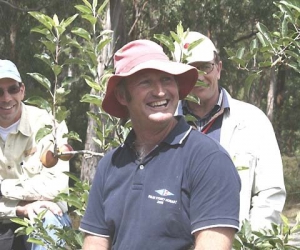
Orchard manager Scott Price worries that restricted varieties, such as Jazz, might split the Tasmanian growers.
“We planted Nagafu, which was going to be the answer to everyone’s problems,” recalled Scott Price, manager of Calvert Brothers’ Rookwood Orchard at Ranelagh in the Huon Valley.
But in Tasmania’s relatively humid climate, the variety developed a huge amount of russet, Price said. The industry has been looking for other strains of Fuji that don’t russet so badly. All the Fujis are exported, and until recently the orchard shipped all its Red Delicious to India.
The orchard, which was developed in 1983, still has some of the original Red Delicious plantings, though Price said the trees are nearing the end of their life. Most of the newer blocks are Braeburn and Gala, including a selection of Gala discovered at that orchard. Calvert Brothers was among the first in Tasmania to plant Pink Lady, despite fears that it would not grow well in a comparatively cool area. But Tasmania does have good coloring conditions.
Jazz
Price said he’d like to try Jazz, a managed variety from New Zealand, but he worries what impact it will have on the Tasmanian fruit industry if only certain growers are allowed to grow it.
“It’s a point of contention,” he said. “Unless you have a foot in the door and are pretty good mates with people, it’s difficult to get some of these varieties. We’ve been very fortunate—we have a good, core group of growers, and I wonder what happens in the future if someone gets Jazz and makes a fortune. It doesn’t mean they’re a better orchardist than someone who doesn’t have Jazz. It will be interesting to see how it goes in the future and if it causes grief among growers.”
Price is also interested in the red strains of Pink Lady, such as Rosy Glow, and still thinks there’s room for more Gala, although Australian growers are concerned about the impact on the market if New Zealand apples are allowed into the country.
Price said he’s running the orchard on a day-to-day basis and there are no big plans for the future. The last major planting, in 2004, was of Gala. This year, he’ll plant a block of Fuji.
“We’re still here and don’t owe the banks anything,” he said. “We run a lean machine here, and we get by.”
Backpackers from mainland Australia do much of the harvest work. Price provides free accommodation and transportation, plus other perks. “We move their bin two inches at a time so they don’t have to walk,” he joked. “That pays dividends in the long run.”
Potential workers hear about the orchard through word of mouth, so Price does very little advertising.
Unlike many other Tasmanian orchardists, he decided not to plant cherries. Cherries, he said, would stand in the way of a good Christmas, and he’d worry too much about rain.
“We probably missed the bandwagon for cherries,” he added.
The orchard is in a rural area with a license to pump directly out of the Huon River and a Wilderness World Heritage Area just 7.5 miles away.
Preventing damage by wildlife is one of his greatest challenges. Wallabies invade the orchard in groups of 100 or 150 and munch on the foliage. “It looks like we had leaf thinners in,” he said. “And wherever we have posts, we have possums.”
Rooks, which arrive in flocks of 200 or so, are “a real pain,” he said. Holes they peck in the Fuji apples attract European wasps, which then sting the pickers.

Leave A Comment